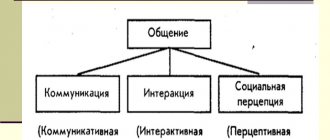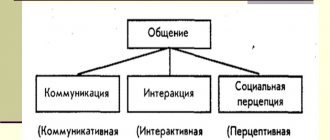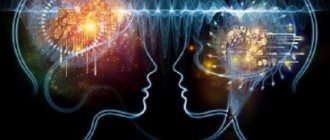- October 10, 2018
- Psychological terms
- Sergey Kostyuchenko Zhelyazkov
Perceptivity is a reflection of reality situations, in which much depends on the individual. Such a display is necessary to form an image of objects. As for psychology, this phenomenon allows us to understand how a person sees a problem and what conclusions he draws as a result of communicating with people around him.
Perception
From a psychological point of view, this is an individual’s reflection at the cognitive level of those objects, phenomena, events with which he interacts. In the case of social interaction, it involves perceiving the other as a separate person with his own characteristics.
Awareness of the opponent's individuality can arise through understanding his beliefs, desires, interests and opinions. This is how an objective assessment of an individual is built, whose characteristics differ from the characteristics of the perceiver.
In this regard, acceptance can also be formed - a complete or partial sharing of the interlocutor’s attitudes and values. It is the foundation for the formation of higher-level relationships: friendship, sympathy, love.
Briefly: thanks to the perceptual side of communication, people are able to read from others what is not voiced and find an approach to them. An incorrect analysis can cause misunderstandings and even conflict.
Manifestations in relationships with others
All people have different perceptual abilities. This depends, in part, on genetics and culture. This quality can also be developed, which is especially important for people whose work is related to communication and teaching. For example, the perceptual abilities of a teacher are the skills of observation, to find an individual approach to each student, regardless of his academic performance, character, or nationality. In relationships with others, perceptive individuals demonstrate a high level of empathy - emotional empathy for the interlocutor.
A person with a high level of development of sensory perception easily finds a common language with others
Functions of social perception and purpose
As a result of evaluating certain objects, various stable images of these objects or phenomena develop in the mind. This process directly affects the socialization of the individual:
- Self-knowledge. A person gets to know himself through the world around him, he receives information about himself during interaction with space. This is what I will teach you in my personal consultation. Sometimes the perception of the individuality of the interlocutor helps to identify important aspects for personal development, hidden interests, and aspirations.
- Getting to know other people. To truly get to know a partner, to understand his views and attitudes, to gain trust and to effectively develop communication is possible only in the process of establishing interaction at the perceptual level.
- Building joint activities. The basis for further building a common reality is understanding and acceptance. Without understanding the interests, beliefs and values of partners, it is impossible to create a model of effective contact with him. The more participants in a group who have to work together, the more significant the role of perception.
- Formation of emotional relationships. In the process of communication between people, certain emotions arise from sympathy, respect or hostility to love and hatred. Perceptual communication helps determine the attitude towards a partner.
Perceptual component
It helps to correctly interpret the appearance and behavior of a person when interacting with her. Without it, our ideas about others would be superficial and ineffective.
Thanks to perception, real thoughts, ambitions, and experiences do not escape our consciousness. However, it can manifest itself fully only if a person is not hostage to stereotypes and limiting beliefs. They do not allow you to objectively analyze the interlocutor and create a certain image in your head in advance, which is often far from reality.
Psychologist Daria Milai
Make an appointment
It is necessary not to rush to conclusions and allow yourself to form a reliable assessment. To get a truly accurate picture of your opponent, you need to communicate with him for a long time, get as much information as possible by observing his behavior in various situations.
It's probably happened that you've met someone you knew in the past and noticed how much they've changed. It becomes possible to reject the already formed perception of his personality and accept the characteristics that he has at the moment.
Basic Concepts
Perceptivity is a basic biological process of the human psyche. This function is acquired through the senses, which take part in the formation of a complete image of objects. Perception influences the analyzers through a series of sensations caused by perception.
It is also worth saying that perceptivity is a popular subject of study among psychologists. After all, such a reflection of reality allows us to form a full-fledged image of a certain phenomenon in the human mind.
Aspects
Perception first appears at the stage of visual analysis of the communication object. Thus, physiognomy claims that there is a connection between an individual’s facial features and his psychological characteristics. Based on an assessment of the interlocutor’s appearance, the first assumptions are made regarding his inner world and behavior.
Then some emotional contact is formed. If the conversation has an unpleasant context, a negative perception of the opponent may well be formed. And vice versa.
In the process of communication, people observe their partner’s speech, facial expressions, gestures, and habits, receiving verbal and nonverbal information about his personality.
Mechanisms of social perception
The perceptual side of communication includes several important tools that allow you to establish effective interpersonal interactions.
Reflection
This is the ability to analyze your actions, draw conclusions from what happened and see possible ways of developing the situation. In building communication, it is relevant at the moment when we are trying to visualize the impression we make on our opponent. The result may or may not meet expectations.
To reflect means to be able to look at the process from the outside, analyze what is happening and try to get to the essence of the problem through rational understanding.
Identification
Identifying oneself with the interlocutor, trying to put oneself in his place and look at the problem through the prism of his perception. This mechanism allows you to better understand and accept the speaker’s position.
Empathy
Represents the ability to empathize and sympathize. The more subtle a person’s mental organization is, the more developed his empathy is. Such people can analyze the internal state of their opponent simply by observing his behavior.
Anthropological, social and aesthetic stereotyping
An assessment of an individual's psychological characteristics is based on various stereotypes. Thus, many believe that deep-set eyes indicate toughness and secrecy, and weak hands indicate a lack of hard work. Personal status, financial situation, and external attractiveness are also taken into account.
Attraction
An assessment of an individual that is based on a stable, long-lasting positive feeling towards a partner. It promotes the formation of closer interpersonal connections: friendship, love, affection.
Casual attribution
Interpretation of phrases and actions of the interlocutor based on personal assumptions and previous experience. This is an attempt to find out the reasons for this or that behavior, but not through observation and obtaining information, but based on one’s own prejudices and conclusions.
Face-to-face consultation
What are the features and advantages of face-to-face consultation?
Find out more
Skype consultation
What are the features and benefits of Skype consultations?
Find out more
Mechanisms of perception
In communication, it is important not just to categorize the opponent by attaching one label or another to him, but to understand, to immerse deeply in the inner world of the partner, to realize his current emotional state, motivation, and attitude to the situation.
However, this is not only the interaction of persons A and B. At the end of the 19th century, Professor J. Holmes described the process of interpersonal communication in an expanded scheme. As many as 6 subjects were included in it. So, who actually participates in the conversation between the conditional John and Henry:
- D., what it really is.
- D., as he perceives himself.
- D., as G. sees him.
- G., what he is.
- G., what he considers himself to be.
- G., as assessed by D.
Later we added one more point to this picture:
- D (G), how he sees his image in the opponent’s head.
Phenomena (effects) of interpersonal perception
Primacy. The idea is that if there is conflicting information after meeting an individual, the facts obtained earlier are perceived as more significant. It is they who influence the formation of a general idea of the stranger’s personality.
- Extremes. Objects located on the edge are remembered better than those located in the middle.
- Novelty. In the case of the perception of a familiar person, data obtained later takes on greater significance.
- Halo. It is the formation of a unique belief associated with the observed through the purposeful attribution of a number of characteristics to it, that is, the learned facts are superimposed on the initially existing image. Thus, a general positive impression contributes to a positive assessment of the known and unknown qualities of an object, while a negative attitude towards it gives rise to deliberately negative assessments.
- First meeting. Assumes a stable conclusion about a person that arose after initial communication. This is especially relevant when future opinions about an individual contradict the existing prototype.
- Projections. In general, people tend to attribute their positive qualities to a pleasant interlocutor, and their own negative qualities to an unpleasant interlocutor.
- Average error. The tendency to soften the assessment of the most striking characteristics of an individual to the statistical average.
- Barnum. Perception of assessments of one's identity as truly true if they are presented through the prism of a scientific, ritual or magical context.
- Boomerang. The information that is presented to the audience causes the opposite effect to the expected one. This is possible when the subject reporting the fact is unpleasant to the group or when its members do not trust the source of the data.
Communication process model
There are several models of the communication process, the most famous of which is Harold Lasswell's concept.
This model originally included five elements, but Lasswell eventually added two more to it, changing the rest slightly. Original model:
- Who? (communicator, source of information, that is, the person who transmits information).
- What? (message sent by the communicator).
- On what channel? (method of transmitting information).
- To whom (recipient, recipient - this can be either one interlocutor or a whole audience).
- With what effect? (reaction to the message received, assessment of the effectiveness of communication).
Augmented model:
- Who? (communicator).
- With what intention? (Lasswell considered this question the most important, because without the motives and goals of communication it is impossible to talk about either channels or the target audience - that is, about communication in general).
- In what situation? (the situation can be of three types: favorable, neutral, unfavorable).
- With what resources? (resources should be understood as the communicator himself, as well as technologies, financial means and methods).
- Using what strategy? (Lasswell believed that every communicator should choose a strategy before speaking, and not just leave things to chance).
- For what audience? (if you know who your audience or interlocutor is, you can persuade them much more effectively).
Characteristics and features of stereotyping: how the perceptual side of communication is manifested in it
Perception is closely related to stereotypes existing in society. Their formation in the process of communication can occur under the influence of a number of circumstances:
- The superiority factor. It occurs in a situation of obvious inequality between interlocutors in a certain area: in terms of financial status, social status, intellectual abilities. A person often overestimates the characteristics of those who are superior to him on a characteristic that is significant to him. Conversely, feeling our advantage, we often underestimate our opponent.
- Degree of attractiveness. One way or another, our perception depends on the emotional component, in particular on sympathy or antipathy. Outwardly attractive people are seen as happier, more confident, and more successful.
- Factor of attitude towards us. As a rule, individuals who treat us well are perceived favorably. Conversely, those who evaluate us negatively appear worse.
All these distortions can most often be observed when forming a first impression of a person. However, to build effective communications, it is worth remembering that stereotyping interferes with an objective analysis of personality.
Ask a question
Communication barriers may also arise when transmitting information. They lead to distortion of the transmitted message and cause misunderstanding between the participants in the conversation:
- use of jargon, unfamiliar words, terms;
- the presence of emotional inhibitions (thoughts and feelings that are difficult or prohibited to demonstrate to another individual);
- lack of interest in the subject of conversation;
- differences in point of view;
- physical disabilities (hearing or speech problems);
- inability to analyze the behavior and state of a partner due to the characteristics of the communication channel (telephone, Internet);
- linguistic or dialectical differences;
- the desire to hear what one wants, and not what actually is;
- differing cultural norms;
- difference in worldview and worldview.
It is simply impossible to get rid of barriers when establishing communication. The spoken remark always reaches the addressee in a distorted form, passing through several levels of his internal “filtering.”
What happens is that during a conversation, the communicator encodes the text, and the recipient decodes it. That is, when wanting to convey information to the interlocutor, it is necessary to isolate its general meaning, which must be conveyed and then “encrypt” it using verbal and non-verbal symbols. When providing feedback, you can understand whether the transmitted ciphers were correctly perceived and interpreted.
To build the communication process as efficiently as possible, you need to know the context in which the dialogue is being built:
- In what social event does it occur?
- Is this formal or informal communication?
- Is this a chance meeting or should the interaction continue in the future?
- Are you included in the game format? Is the problem being discussed serious and real?
Based on the answers to these questions, you can choose the appropriate behavior style:
- Humanistic. Aimed at mutual knowledge of the inner worlds of opponents, which generates empathy.
- Manipulative. An attempt to impose your position on the interlocutor. The mechanism can be used in both positive and negative ways.
- Ritual. Assumes the presence of actions expected within a given cultural framework.
Transactional analysis will also help to establish contact. This is a way of organizing communicative interaction based on regulating the positions of opponents. The personality of each person includes three roles: parent (talks about what needs to be done), adult (harmoniously combines desire and necessity) and child (relies solely on emotional “wanting”). To communicate effectively with people, you need to ensure that these categories coincide. Otherwise, there is a risk of not being able to correctly perceive what was said.
By understanding the context and choosing the appropriate conversational style, you can steer the conversation in the right direction.
In cognitive science, psychology, psychophysiology and philosophical literature, researchers resort to a lot of numerical classifications of consciousness. Very useful for some research problems is the fairly common (mainly in descriptive psychology and some philosophical directions) identification of levels of consciousness - the preconscious (subconscious) and the unconscious. A stricter and more accurate differentiation, in our opinion, would be to attribute these levels to the functioning of the structures of the human cognitive system, to the processes of processing cognitive information occurring in it, since the “unconscious” in the most general sense only means that there is a level cognitive activity, not subject to conscious control, and therefore not belonging to the sphere of consciousness. Apparently, the level of the “unconscious,” if not limited to its specific definitions put forward in the works of S. Freud, C. Jung and other psychoanalysts, can also be analytically differentiated into several levels. In addition, it is necessary to take into account that a huge number of biological processes take place in our body, which are most likely completely autonomous not only from consciousness, but also from the work of our cognitive system. Directly genetically, for example, the growth of hair and nails is controlled, which continues even for some time after the death of people. Although these types of processes are not controlled by our consciousness and in this sense they are indeed “unconscious”, they, of course, cannot be attributed to the unconscious levels of information processing by our cognitive system. From our point of view, only the processes of processing cognitive information can be classified as “conscious - unconscious - unconscious”.
On the other hand, people who do not have special training are usually unable to consciously control their heart rate, their blood pressure levels, body temperature and many other physiological processes occurring in the human body, although they are controlled by our nervous system. Does this mean that the processes of processing cognitive information that control our physiological states are generally unconscious (i.e., they belong to the levels of the unconscious)? With the help of appropriate autogenic training
fears and self-hypnosis, many of us, however, can learn to restore
accept and be aware of cognitive information about the work of their heart, they can even control the rhythm of the heart muscle within certain limits. After training, trained people also acquire the ability to significantly lower their blood pressure or increase the temperature of a localized area of their body by several degrees. (Many species of animals with sufficiently developed self-perception have much greater ability to control their physiological states.) But then it turns out that our conscious “I” still has access to the structures of the nervous system that control certain physiological processes and can influence them work. Since the transfer of cognitive information about some of one’s physiological states into the field of consciousness does not present any particular difficulties for a trained person, is this not evidence that this information is still localized at the preconscious level?
Certain difficulties also arise with the special kind of cognitive information that many people are able to create on the basis of signals received at a subsensory level. They are sensitive to changes in atmospheric pressure, electromagnetic and geomagnetic fields, etc., affecting their body and its internal state. The ability to perceive signals at a subsensory level was apparently inherited by hominids from their distant non-hominid ancestors. Under certain conditions, information created on the basis of signals extracted at the subsensory level does not enter the field of consciousness and can be partially realized. However, the ways of transmitting this kind of cognitive information, how and in what way it is created, where the centers for its processing are localized in our brain, etc. - all this still remains unclear.
And, finally, the question arises: to what level should fully conscious processes of processing cognitive information be attributed, which at the same time remain outside the sphere of conscious control? A typical example here can be thought processes occurring during the period of a transformed state of consciousness - sleep. As many researchers believe, dream scenarios that are completely out of our conscious control are the result of sensory deficits that develop during sleep. This is confirmed by experiments on sensory deprivation, when subjects who spent a long time in an isolated room experienced visual hallucinations while awake. Although global and local brain activity decreases during sleep, our cognitive system
Apparently, he still strives to “compensate” for the sensory deficit by launching consciously uncontrolled thought processes. Our reduced, perceptual consciousness is capable only of passive
“contemplate” this mental activity. It is characteristic, however, that information about the symptoms of many impending pathological changes in the human body sometimes receives symbolic representation in consciously uncontrolled dream plots.
In cognitive psychology, where cognitive processes are considered from the point of view of models of information processing, the differentiation of consciousness proposed by E. Tulving into three types - anoetic, noetic and autonoetic - which is believed to be associated with the use of three types of memory has received quite wide recognition: procedural, semantic and episodic. Anoetic (or “not knowing”) consciousness is limited in time to a specific current situation. It allows a person only to record perceptually perceived information and respond with his behavior to changes in the environment. For such consciousness, the cognitive resources of procedural memory, which retains knowledge related to skills and abilities, are sufficient. Noetic (or "knowing") consciousness makes it possible to be aware of events, objects and the relationships between them, even if they are not in the field of perception or exist only as ideal conceptual structures. This type of consciousness is somewhat similar to symbolic (verbal) consciousness and involves the use of semantic memory resources. And finally, the most complex type of consciousness is autonoetic (or “self-aware”) consciousness. It allows you to reproduce personally experienced events, facts of personal life, etc. This consciousness is associated with the work of episodic memory, since it is capable of storing information about the events of an individual person’s life.
This classification of types of consciousness, based on the types of memory identified in cognitive psychology, may seem rather formal only at first glance. It deserves the closest attention, since the specific work of consciousness as the ability to control other, lower cognitive abilities (for example, sign-symbolic (logical-verbal) thinking) psychologists and neuropsychologists have not yet been able to study experimentally separately, separately from the workings of these mind-controlled abilities. Our (symbolic) co-knowledge is always intentional (of course, if it works), but
it is not directly directed at the external world or even at a specific object or object (including the ideal one), as was believed, for example, by F. Brentano, E. Husserl, J.-P. Sartre and others, and on the control of lower cognitive processes - pattern recognition, attention, memory, symbolic thinking, etc. The perception, attention and thinking of animals that do not have consciousness are intentional. The work of their cognitive abilities, within certain limits, is controlled by structures associated with self-perception. Thus, the intentionality of our (symbolic) consciousness is “second order” intentionality. When we notice and begin to carefully examine a thing, it really becomes an “object of our consciousness,” but only metaphorically, indirectly, due to the ability of our consciousness to control attention, pattern recognition and direction of visual perception, etc. In itself our consciousness does not perceive, does not think and does not remember, it also cannot be identified with attention. For human symbolic (verbal) consciousness, some lower cognitive abilities (but not all) turn out to be a kind of tools that it is only able to manipulate within certain limits. Given the above, we must be aware of the enormous difficulties faced by indirect approaches to the study of consciousness through its subordinate lower-level cognitive abilities (for example, memory or attention), although the latter are amenable to direct experimental study. But this, naturally, does not detract from their value.
Since consciousness and other higher cognitive functions have undergone co-evolutionary changes during the biological (cognitive) evolution of human populations, some stages of the evolution of consciousness may indeed coincide with the corresponding stages of the evolution of memory systems. However, if each type of memory is associated with a certain type of consciousness, then a number of problems inevitably arise, related, in particular, to the fact that the cognitive system of hominids inherited some types of memory from non-hominid human ancestors. So, for example, the “ignorant” consciousness is, apparently, phylogenetically the “primary”, evolutionarily the earliest variety of trustful consciousness of hominids. However, it is hardly possible to say with certainty that no knowledge at all fell into the field of this type of consciousness. We are, of course, not talking about verbalized knowledge (and other verbalized cultural information) or verbal representation.
tations of thought. But this consciousness at least had to have perceptual knowledge (cognitive information) that its bearer is a living being, isolated from the outside world, is an autonomous “self”, isolated from the environment. Without relatively high-level perceptual self-recognition there is and cannot be any consciousness. At the same time, it should be taken into account that the cognitive structures that ensure the functioning of procedural memory arose in organisms in the course of biological evolution long before the appearance of higher anthropoids, who possessed rudimentary consciousness and self-awareness. Procedural knowledge is acquired and remembered by many animal species. Anthropoids purposefully teach their young the simplest knowledge how - how, for example, to make a tool for hunting ants or to crack a nut with a stone. The acquisition by the most ancient hominids of elementary skills and other procedural knowledge, as well as their memorization, most likely did not require the controlling participation of preverbal, perceptual consciousness. It is also clear that the procedural memory of modern humans is incomparably more developed and functions in close cooperation with semantic memory. It is controlled by our symbolic (verbal) consciousness and, because of this, includes the symbolization of large sequences of operations, scenarios and patterns of human action. It also stores information about the rules for manipulating symbols and constructing symbolic expressions.
Before hominids had relatively developed speech, symbolic-symbolic (logical-verbal) thinking and symbolic (verbal) consciousness, their cognitive system apparently did not need structures responsible for semantic memory. From this point of view, “knowing” consciousness is a synonym for symbolic (verbal) consciousness, which is capable not only of controlling other cognitive functions within certain limits, but also possessing verbal, including reflective, knowledge about itself. The situation is more complicated with autonoetic, “self-aware,” co-knowledge, since episodic memory is also a very ancient evolutionary acquisition. Animals with sufficiently developed self-perception and perceptual thinking easily remember and store in long-term memory perceptual images and ideas about events perceived in the past and the connections between them. Without accessing the resources of their episodic memory, without correlating its perceptual information content with information about themselves, they would be unable to think and learn on their own. Therefore, the “self-aware” human consciousness
assumes at least close cooperation between episodic and semantic memory, which, among other things, is due to the dual encoding of cognitive information characteristic of our cognitive system. Human symbolic (verbal) consciousness allows us to mentally reconstruct the perceptual, figurative information about past events stored in our episodic memory as a symbolic time sequence of facts of our personal biography. A consciousness that is “aware of itself” must therefore necessarily be “knowing.”
The identification of knowledge and consciousness has a long epistemological tradition. This identification follows from the etymology of the term “consciousness” itself, which comes from the Latin words cum and sciare, meaning “common, shared knowledge” when translated into Russian. Of course, the common property of human populations is not only knowledge, but also any cultural information (including beliefs, myths, mythologized ideology, etc.). Due to the enormous difficulties of experimental research into the very phenomenon of consciousness as such, in isolation from the work of the higher cognitive abilities “subordinate” to it (I. Kant, for example, believed that we, in principle, cannot have knowledge about the work of our consciousness), the identification of consciousness and knowledge remained until recently a very common concept also in cognitive science: consciousness is primarily “knowledge about events or stimuli in the environment, as well as knowledge about cognitive phenomena such as memory, thinking and bodily sensations”73. It is clear, however, that our consciously recorded knowledge is only a very superficial aspect of the work of consciousness, empirically accessible to our introspection and introspection, which is not armed with experiment. Our consciousness “knows” only due to the fact that it controls higher cognitive abilities. It uses the results of their “work” in order to make some adjustments to it, and even “forces” our thinking to generate ideal techniques, rules and strategies. Consciousness sets a goal and outlines a scheme of actions; it chooses which system of actions will dominate, how and by what means it should act to achieve the goal.
From the point of view of evolutionary-informational epistemology, a very useful and productive tool for analyzing the phenomenon of consciousness can be the distinction between two types and simultaneously two cognitive levels of conscious activity - perceptual consciousness and symbolic (verbal) consciousness. This distinction is
is in good agreement with modern experimental data indicating that people have two closely interconnected systems for processing cognitive information, localized in the right and left hemispheres, as well as with numerous data from relevant clinical observations. This distinction allows us to analytically highlight the most important stages in the evolution of human consciousness and the functional differences between its relatively lower and higher cognitive levels.
Perceptual consciousness is our relatively low-level consciousness, based on the joint work of the cognitive structures of the right hemisphere. It manifests itself primarily in perceptual self-awareness, in awareness of one’s non-verbalized “I”, in “recognition” of oneself and recognition of one’s informational difference from the environment and other people. It includes a conscious sense of self and perception (even if very vague) of oneself as a complex of information signals coming from the proprioceptive internal reactions of one’s body and the cognitive processes occurring in it, as well as conscious emotional reactions to oneself, to one’s self-perceptions. Our perceptual consciousness is both a conscious self-awareness of the unity of our physical and cognitive existence and our separate, autonomous being, our uniqueness, our “self” and ourselves as an active living being that remains identical to itself in time. Finally, this is the awareness of our deep sense of self that, despite the unity of our bodily and cognitive existence, the work of our cognitive system seems to bifurcate in two directions - it sees, hears, touches, understands, thinks, experiences, etc. , but this work is carried out by a self-recognizing “person” who sees, touches, hears, thinks, experiences, etc. We self-perceive ourselves, our “self” as an internal, perceptual-mental representation of cognitive information about ourselves, our own knowledge about yourself and your conditions.
Our perceptual consciousness is not involved in the control of higher cognitive abilities, but it allows us to perceptually “know” that we exist and constantly “informs” us about this. Thus, perceptual consciousness acts as a tool for information control of a person’s internal states. This function follows from the phylogenetic roots of perceptive self-awareness, which most likely arose as a result
buffering of cognitive information “excessive” for self-perception. Because of this, perceptual consciousness in a cognitive, informational sense is closely integrated with our unconscious self-perception, including, apparently, with its subsensory level. This deep, phylogenetically more ancient unconscious perception itself, apparently, turns out to be for us that cognitive level that is significant for our perceptual consciousness, which psychologists and philosophers traditionally consider as the “unconscious”. Our perceptual consciousness is fundamental in the sense that only with its presence, with the presence of perceptual self-awareness, is the formation and functioning of a higher-level symbolic (verbal) consciousness possible. It is perceptual consciousness that is initially formed during the cognitive development of the child; it is present (albeit in reduced forms) even in extremely weak-minded people who are not capable of verbalizing thoughts from birth, or in patients who have completely lost their speech and thinking abilities, as well as their control symbolic (verbal) co - knowledge as a result of injuries and illnesses.
The outstanding Russian psychiatrist V. M. Bekhterev, who specially studied the dynamics of degradation of consciousness in mentally ill patients, with amazing observation recorded the minimum possible function of our relatively low-level, phylogenetically “primary” perceptual self-awareness: “...the ability of self-cognition is initially lost, then those series of ideas, the totality of which serves as a characteristic of the moral personality of a given person: over time, in this kind of patients, the consciousness of time, and then the consciousness of place, is lost, while self-awareness and consciousness of the “I” as a subject remain for the most part undisturbed even with a significant degree of dementia... In some cases of extreme decline in mental abilities, these elementary and at the same time more persistent forms of consciousness are lost, and from all the mental wealth a person is left with only one vague sense of his own existence...”74. Perceptual consciousness is the first to come to us, allowing us to realize our own existence in this world, and the last to leave us.
Human consciousness acquired the ability to control thought processes and other higher cognitive functions in the course of biological (cognitive) evolution thanks to the development of speech communication, natural languages and “secondary”, verbal and symbolic non-verbal coding of thought. Appearing
The development of these new cognitive abilities was accompanied by the generation in the left hemisphere of the brain of high-level control cognitive structures associated with the centers of self-consciousness. By virtue of
Because of the “secondary nature” of verbal codes, conscious manipulation of symbols could not be blocked by relatively low-level, genetically controlled strategies of right-hemisphere spatial-imaginative thinking. Therefore, in the course of evolution, our symbolic consciousness began to gradually acquire greater freedom of choice in managing the processes of optimization and construction - tivization of ideal conceptual systems of left-hemisphere sign-symbolic thinking. Not only was it able to give sign-symbolic thinking some
“external” tasks and manage the general course of mental transformations, but also “internal” tasks associated with the use of certain mental strategies, techniques and methods. that is, the problem of optimization and constructivization of the analytical strategies used by this thinking. The successful solution of these problems opened up to humanity the world of ideal rules for mental operation of symbols and conceptual systems, and made it possible to develop techniques and methods of scientific knowledge. Symbolic consciousness, of course, is not able to “cancel” or change our imaginary cognitive space, but due to the dual encoding of mental information inherent in our cognitive system, it can initiate our imagination to generate an ideal mathematical space.
Of course, our symbolic consciousness works in close cooperation with perceptual consciousness, with our relatively low-level non-verbal “I”, which provides self-perception and self-perception of our existence as a separate, autonomous and unique living being, considering itself separate from the environment. Thanks to the internal perceptual-mental representation of acts of self-recognition, it is the non-verbal “I” (presuming a single complex of “I-images”) that turns out to be identical to self-awareness, perceptual self-awareness. Apparently, the evolution of symbolic consciousness was accompanied by the development of “secondary” verbal coding of the meanings of some perceptual “I-images” (i.e., only individual elements of perceptual self-awareness), which turned out to be in demand for the needs of interpersonal speech communication, the development of symbolic symbolic thinking and symbolic culture. As a result of the generation of “I-concepts”, a verbalized
new, reflective self-awareness. On behalf of the “I-concepts”, symbolic (verbal) consciousness gets the opportunity to control symbolic thinking and other higher cognitive abilities of people, to explore and optimize human thinking, to study a person and his consciousness.
Due to interhemispheric cooperation, interconnection and complementarity of the cognitive structures of perceptual and symbolic (verbal) consciousness, human consciousness is one (except, of course, in cases of pathology). There are not and, apparently, there cannot be two autonomous “consciousnesses”: one for spatially imaginative thinking and spatial functions, and the other for sign-symbolic (logical-verbal) thinking and verbal knowledge. Of course, in the course of the cognitive evolution of individual human populations, symbolic (verbal) consciousness becomes dominant, and this, naturally, makes significant adjustments to the mechanisms of its cooperation with perceptual consciousness.
There is very strong experimental evidence to suggest that in the case of a dominant left hemisphere, our right hemisphere has extremely limited direct access to conscious experience. Our symbolic (verbal) consciousness functions as a mediator and interpreter of cognitive information coming from the right hemisphere - it seeks to adapt this information to its verbalized conceptual evaluation systems, and sometimes even block and suppress it. But, we repeat, this does not negate the unity of our self-awareness, the unity of our “I”. Neurosurgeons' observations of patients indicate, in particular, that in the waking state, awareness of verbal acts requires their filling with specific perceptual content, which is provided by a consciously directed selection of images from the repertoire of episodic memory. Apparently, the verbal activity of our left hemisphere is directed by the intentionality of the right hemisphere, and the conscious activity of imaginative thinking is directed by the intentionality of the left hemisphere. Human perceptual consciousness (together with right-hemisphere thought processes) most likely plays an extremely important role in acts of understanding, in identifying semantic connections between elements, parts and the whole, being, as it were, a “mediator” in these matters between spatial-figurative thinking, on the one hand, and sign-symbolic (logical - verbal) thinking and symbolic (verbal) consciousness - on the other.
As paradoxical as it may seem at first glance, due to its informational nature, consciousness as a cognitive method of hominids arises and exists outside and independently of our conscious control - from our will, desires, conscious actions, etc. Of course, consciousness as cognitive ability should be differentiated from joint, social consciousness. It would be more correct to include as social consciousness not only general knowledge, but all types of cultural information common to ethnic groups and populations (acquired and memorized with the participation of consciousness as a cognitive ability). In the information field of consciousness of individual people, their individual knowledge may also appear, including implicit knowledge, which is not always and not fully realized, and in the acquisition of which symbolic consciousness did not participate. Such, for example, are the procedural knowledge and arts that constitute the secret of individual mastery.
Of course, the world around us exists outside and independently of the ability of our cognitive system to consciously manage higher cognitive functions on behalf of verbalized, reflexive “I-concepts”. But this world was largely created thanks to our conscious efforts. The state of our environment also depends on the information content of consciousness, on our knowledge and other types of cultural information acquired with the participation of the human “I,” since adaptively valuable information can be used by people to change it (although, unfortunately, it is far from always for the better). We can change this environment only within certain limits if we do not want to jeopardize our adaptability to the world around us.
The development of our “I” is informationally represented at the level of our cognitive system in numerous “I-images”, and then “I-concepts”. In the first months of his life, the child does not yet perceive himself as something different from his environment. It is only between 16 and 30 months that he gradually becomes aware of his body and its boundaries, as well as the bodies of other people. He discovers that the objects around him - furniture, toys, as well as his parents and other members of his family - are something different from himself. It is at this time that he, sitting in front of the mirror, begins to study his body and ask himself the question of the reality and unreality of his own existence. By about two years old, he already knows about the existence of his “I”. If earlier he called himself only by name, as his family members did, now he says: “I.” He
already knows that his “I” is capable of taking, seeing, hearing, touching, speaking, having and even giving. This child’s self-awareness is not yet reflexive, but it is precisely this that underlies his emerging “I-images.” The formation of a “Self-image” begins with the awareness of what we appear to others; this image depends both on our own ideas about other people and on these people’s ideas about ourselves. Thus, our childhood “I-image,” our self-image, as well as our level of aspirations (i.e., “spoiledness”) turn out to be the result not only of personal experience, but also of the experience of communicating with our environment within the framework of a particular culture.
A small child, still completely weak and defenseless, completely dependent on parental authority and care, is aware (of course, at his own level) of himself and his role in the family, and this awareness leaves a deep imprint on his idea of himself throughout his life. all my life. In the future, other numerous and changing “I-images” and “I-concepts” will be formed in his consciousness, associated with the roles that he will be destined to play at school, university, army, at work, in relationships with friends, bosses and other people. But a fuzzy, unarticulated perceptual idea of his position and his role in childhood, his childhood “I-image” will remain an unconscious guide for him in search of the “true” image of what he really is.
Our symbolic (verbal) consciousness, through its articulated and reflexive “I-concepts,” directly controls the acts of image recognition, thinking, memory, creativity, etc. When we metaphorically talk about “the consciousness of a mathematician,” “the consciousness of an engineer,” “ consciousness of a chess player”, etc., in reality this only means that specific individuals have specific “I-images” and “I-concepts”, associated with the corresponding databases and knowledge that ensure the high efficiency of their professional (mathematical, engineering etc.) thinking.
So, the evolution of self-awareness and consciousness (as well as other higher cognitive functions) of human populations is the result of their biological (cognitive) and cultural evolution. The level of evolutionary development of consciousness and other higher abilities achieved by the subspecies of Homo sapiens served as a cognitive prerequisite for the formation of a truly human spiritual culture75. Thanks to the further cognitive evolution of individual human populations and the development of their culture (science,
Material taken from: Cognitive abilities - Merkulov I.P.
(Visited 241 times, 1 visits today)










